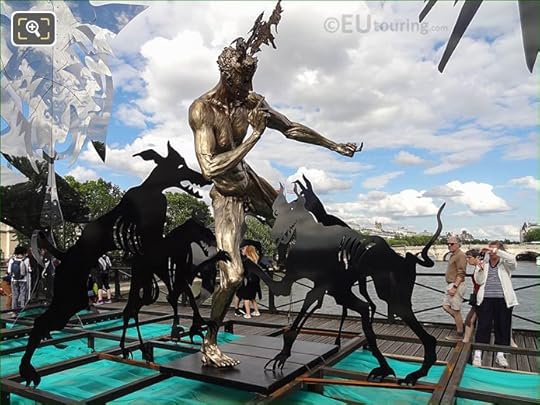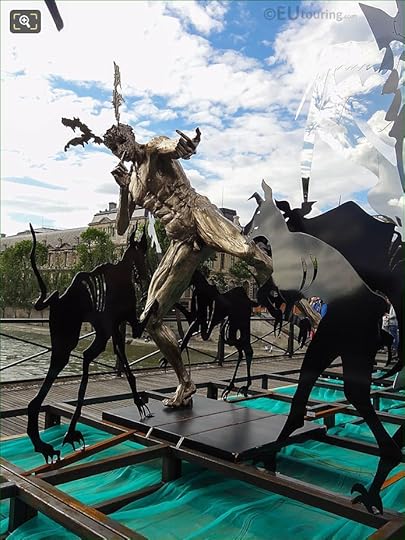 Kalliope’s
Comments
(group member since Aug 28, 2018)
Kalliope’s
Comments
(group member since Aug 28, 2018)
Kalliope’s
comments
from the Ovid's Metamorphoses and Further Metamorphoses group.
Showing 421-440 of 610
 Roger wrote: "HANDEL. There are several sound recordings of Handel's Semele. Although theoretically not an opera but a dramatic oratorio, it has also received many stage productions. All the ones I can find on Y..."
Roger wrote: "HANDEL. There are several sound recordings of Handel's Semele. Although theoretically not an opera but a dramatic oratorio, it has also received many stage productions. All the ones I can find on Y..."Thank you, Roger for your guidance on the opera/oratorio of Semele.
I will try to watch, at least part, of those two versions you gave us.
I have told you already (posted in a comment of one of your reviews), that I watched a live production by the NY City Opera, back in 2006.
The production was quite amusing since it presented Jupiter as JFK, Semele as Marilyn, and Juno obviously as Jackie.
Here are a couple of reviews:
https://www.nytimes.com/2006/09/15/ar...
https://www.ft.com/content/c06d3c0c-4...
I particularly liked the scene in which Juno, trying to convince Semele to ask Jupiter to show himself in all splendour, for which Semele is reluctant, tells her that Semele herself is becoming more and more like a Goddess, that she should look herself at the mirror.
Instead of mirrors they had placed large billboards around the room with magazine covers showing the very glamorous Marilyn... A true DIVA.. haha...
Since I am a great fan of Handel's operas I have purchased the DVD with Cecilia Bartoli. I have not watched it yet but hope to do so soon. Will come back to this.
 Ilse wrote: "On Gustave Moreau's Jupiter and Semele (1894-95) proportions are quite different.
Ilse wrote: "On Gustave Moreau's Jupiter and Semele (1894-95) proportions are quite different. ..."
Thank you, Ilse.. the Moreau painting is quite suitable... the preciosity plus a more convincing use of different scales, for me makes it a more successful representation.
I will just add its date and location.
Gustave Moreau. Jupiter & Semele. 1894-95. Gustave Moreau Museum.
 Kalliope wrote: "Jacob Jordaens. 1636-38. Prado.
Kalliope wrote: "Jacob Jordaens. 1636-38. Prado. ..."
By the way, I don't know whether you have noticed that the Main Banner of this Group comes from the Jordaens version of Cadmus and Minerva...
 Roman Clodia wrote: "For those in the group wanting more unity in Ovid's stories, all the tales in this book are from the Thebes cycle as Historygirl mentions, showcasing Ovid's engagements with Athenian tragedy: the Seven Against Thebes is subtly referenced a few times plus the story of Pentheus, of course, taken from Euripides' Bacchae...."
Roman Clodia wrote: "For those in the group wanting more unity in Ovid's stories, all the tales in this book are from the Thebes cycle as Historygirl mentions, showcasing Ovid's engagements with Athenian tragedy: the Seven Against Thebes is subtly referenced a few times plus the story of Pentheus, of course, taken from Euripides' Bacchae...."Thank you for this 'Theban information'...
 Roger wrote: "
Roger wrote: "Sebastiano Ricci: Jupiter and Semele. 1695. Florence, Uffizi."
I find this painting arresting but strange... Jupiter is there twice - in human heroic form and as an eagle... and then his human form although very heroic on its own, is in an awkward smaller scale to Semele's - which belittles his presence...
And then Semele's strong body, in all its 'Michaelangelesque' form ought to be able to withstand the somewhat diminished Jove...
:)
 Historygirl wrote: "..."
Historygirl wrote: "..."Yes, very true... each book enters around 'a world'... I had not thought about this.
I also loved the description of the dragon - and that is why I liked the Goltzius painting even if to our eyes may seem a bit like a caricature.
As for Actaeon's bad luck - I see it as a string of mishaps - not any one is responsible for the whole string of curses - each step follows the previous one which I suppose adds to the feeling of inevitability that constitutes tragedy. Again, I see Diana as wanting to stop him speaking.
 Roger wrote: "
Roger wrote: "Late last night, I added a slightly tongue-in-cheek post (#71) to the General Chat section of the group. I was..."
Great idea, but I find it difficult to rate.. partly because we are very much at the beginning of the Met.
The Actaeon has the musical development that Europa does not have.. and then as RC says, the Daphne has had a tremendous repercussion on poetry (I had already forgotten Daphne, although it probably my favourite so far).. The Europa still lives (Beckmann and Serov) may be because it can be used nowadays for the current Europa political/economic unit.
 Roger wrote: "
Roger wrote: "I thought that question was obvious: to the nudes! There are cert..."
Yes, indeed the nudes.. in particular with the 'voyeur' implication... But the figure of Diana herself, as virgin AND hunter seems peculiar to me.. and often this kind of painting were intended for hunting lodges or mansions.
 Going back to the Actaeon, as with other myths, Titian's poesie for Philip II, clearly come at the top. But with its display of nudity and the theme of 'voyerism' and the hunting context it would prove to be one of the enduring myths.
Going back to the Actaeon, as with other myths, Titian's poesie for Philip II, clearly come at the top. But with its display of nudity and the theme of 'voyerism' and the hunting context it would prove to be one of the enduring myths.It is interesting to see to which of the two aspects, the nude or the hunt does the painter give more attention.
A few less well-known ones:
Giacomo Ceruti. 1744. Palazzo Arconati Visconti, Milan

And, at least for me, an unlikely candidate:
Gainsborough. 1785-88. Royal Collection.
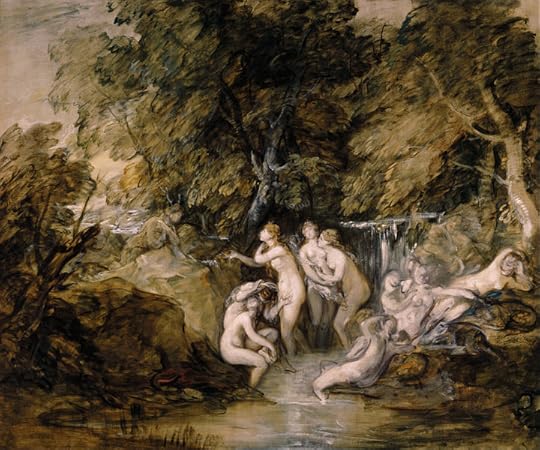
(view spoiler)
An appealing subject for a painter who has sort of gone out of fashion even though he inspired the settings of many Hollywood movies on Roman times. I like him; he is peculiar.
Jean-Léon Gérôme. 1890s. Private Collection.

The scene has been transposed to more modern times - notice the hunters riding in the background - wearing the red jackets. Haha. I love the colours.
And then by the painter who inspired the Impressionists. Emphasis on the landscape again.
Camille Corot. 1836. Metropolitan, NY.
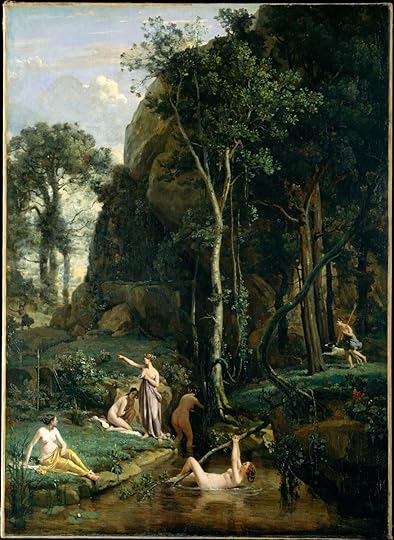
All the above post-Titian. Before him we have also this delightful one by Cranach. An entirely different conception. Cranach liked these ponds with naked women.
Lucas Cranach the Elder. 1528. Wadsworth Atheneum, Hartford, CT.
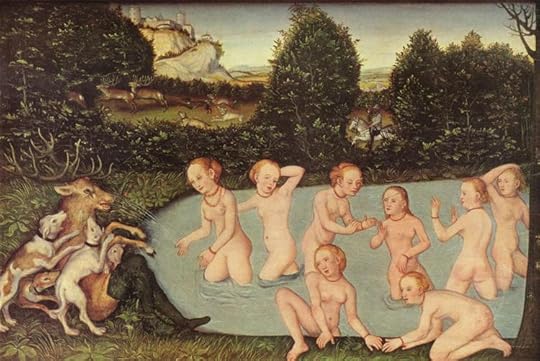
The pictorial repertoire seems endless.. Another winner - like Europa.
 Roger wrote: "OLDER CADMUS IMAGES..."
Roger wrote: "OLDER CADMUS IMAGES..."The Louvre krater is a popular one.. I like the Verona version you posted. I did not know it.
 Roger wrote: "CADMUS BY GOLTZIUS. .."
Roger wrote: "CADMUS BY GOLTZIUS. .."Thank you, Roger.. yes, Goltzius treated them all... when we don't have any outstanding paintings there are always his engravings since he illustrated the entire work.
That is why I find it striking that even though he had a pictorial repertory for the entire poem, he chose this particular myth once he moved to this other medium.
 Vit wrote: "The archetype of dragon seems to have been known since the most ancient times…
Vit wrote: "The archetype of dragon seems to have been known since the most ancient times…."
Gosh, yes, the dragon is such a pervasive element in ancient cultures.. that is a perduring symbol...!!!
 Jim wrote: "On e would think that after a number of years on GR I would have learned all this. .."
Jim wrote: "On e would think that after a number of years on GR I would have learned all this. .."Jim, if you still want to have a go, I suggest you copy the imaged address I posted above and try whether it works for the commands - if so then you just have to concentrate on the getting the image address.
 More on the dogs...
More on the dogs... Wiki has a whole chart comparing the names of Ovid's dogs with those in other accounts..Apollodorus's and Others...!!!
Entry on Actaeon.
 Elena wrote: "Naming the dogs always reminds me of Santa's reindeer, I think it is a kind of oral history trope..."
Elena wrote: "Naming the dogs always reminds me of Santa's reindeer, I think it is a kind of oral history trope..."Haha.. Santa is being pulled by young Actaeons...
 In the scene in which the men spring from the planted teeth.
In the scene in which the men spring from the planted teeth.My Simpson edition clarifies that "in Roman theatres the curtains were raised or lowered from the floor, lie a window shade, but in reverse. It was down at the beginning of the play, so that the stage was visible, and was dawn up at the end, in order to cover it. As it was being drawn up figures inwoven or painted on it would gradually become visit.e, firs their heads, finally their feet."
I was a bit confused when I read in the Ovid text that as the curtain was raised, one saw the faces first...
 But the version by Hendrik Goltzius (we've seen several of his prints in the earlier themes) has a more interesting rendition of the serpent.. here with three heads - not just three rows of teeth and three tongues.
But the version by Hendrik Goltzius (we've seen several of his prints in the earlier themes) has a more interesting rendition of the serpent.. here with three heads - not just three rows of teeth and three tongues.Goltzius began as an engraver but moved into painting later in his career.
Hendrik Goltzius. 1573-1613. Koldinghus, Denmark.
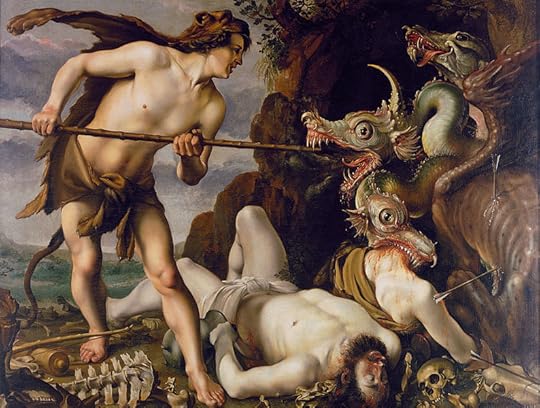
 We have jumped over Cadmus. The beginning of the chapter made me think of The Marriage of Cadmus and Harmony, which I read many years ago and may revisit after we finish with Ovid.
We have jumped over Cadmus. The beginning of the chapter made me think of The Marriage of Cadmus and Harmony, which I read many years ago and may revisit after we finish with Ovid.Interesting that Cadmus endured exile, as Ovid would himself suffer after (?¿) he finished the Met.
As we do not have the original manuscripts but only Medieval copies it must be very hard to try and ascertain how much, if at all he revised while in exile.
Anyway, the most famous painting is that by
Jacob Jordaens. 1636-38. Prado.
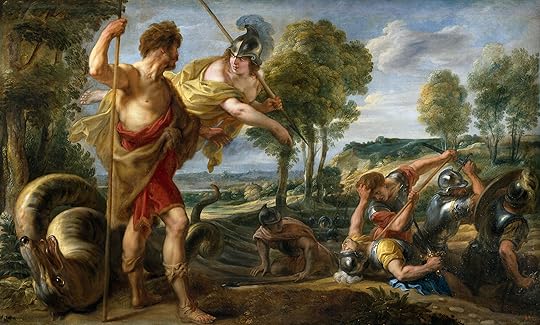
Based on a Rubens sketch. Private collection.
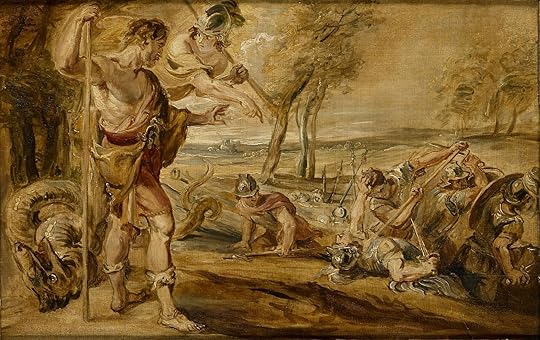
This formed part of the decoration program for the Torre de la Parada - the hunting lodge of Philip IV.
Rubens has conflated the various stages of the story. The snake has just been killed, Minerva is there, and the teeth have been transformed into young fighting warriors.
 But I loved the sculpture in Caserta, Roger. Thank you... the fountain/pond is the perfect place for such a composition.
But I loved the sculpture in Caserta, Roger. Thank you... the fountain/pond is the perfect place for such a composition.
 In the 'Post des Arts' in Paris there was an exhibition of modern sculpture with one Actaeon composition.
In the 'Post des Arts' in Paris there was an exhibition of modern sculpture with one Actaeon composition.